5 Secrets for the Best Fried Chicken Recipe at Home
Fried chicken is more than just a meal—it’s a beloved comfort food that brings warmth, flavor, and nostalgia to every bite. Whether you’re cooking for family, friends, or just treating yourself, knowing how to make the best fried chicken recipe at home can turn an ordinary dinner into a crispy, juicy masterpiece.
The key to perfect fried chicken lies in selecting the right chicken cuts, marinating them for maximum flavor, and using the proper breading and frying techniques. In this guide, we’ll walk you step-by-step through a crispy fried chicken recipe that’s easy to follow, packed with flavor, and guaranteed to impress. From the juiciest chicken marinades to golden, crunchy coatings, you’ll learn everything you need to create restaurant-quality fried chicken right in your own kitchen.
Get ready to discover tips, tricks, and secret techniques that make your fried chicken irresistibly crunchy on the outside and tender on the inside—every single time.
Introduction to Homemade Fried Chicken
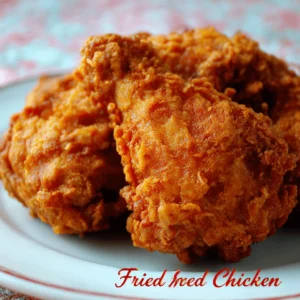
Marinating chicken in buttermilk for juicy, tender fried chicken
What Makes a Fried Chicken Recipe “The Best”
When people search for the best fried chicken recipe, they’re usually looking for one thing—the perfect balance of crispy coating and juicy, flavorful meat. The best recipes don’t just rely on frying alone; they combine technique, seasoning, and preparation to create a dish that feels special every time.
First, it’s all about the crispy coating. A great fried chicken recipe uses a well-seasoned flour mixture (often enhanced with spices like paprika, garlic powder, and cayenne) that clings to the chicken and turns golden brown during frying. This crunchy outer layer should deliver a satisfying crunch with every bite, while sealing in the natural juices of the chicken.
Second, the chicken itself needs to stay tender and juicy on the inside. That’s why many cooks use a buttermilk marinade or seasoned brine. The acidity of the buttermilk helps tenderize the chicken, while the spices infuse flavor deep into the meat.
Finally, temperature control is key. Maintaining the right frying temperature ensures that the coating crisps up without burning, while the meat cooks evenly all the way through. Done correctly, you get fried chicken that’s golden, crunchy, and irresistibly moist—qualities that make it stand out as the best.
In short, the best fried chicken recipe delivers crispy perfection on the outside and juicy satisfaction on the inside, making it a dish everyone craves.
What Makes a Fried Chicken Recipe “The Best”
When it comes to comfort food, nothing beats the satisfaction of biting into a piece of crispy fried chicken that’s perfectly seasoned and cooked just right. But what actually makes a recipe worthy of being called the best fried chicken recipe? It’s not just about frying chicken in hot oil—it’s about mastering a combination of texture, flavor, and technique.
The Crispy Coating:
A great fried chicken starts with a well-seasoned breading that transforms into a golden, crunchy shell when fried. This crispy coating should be flavorful on its own, but also light enough to let the juicy chicken shine through. Using flour blended with spices, sometimes combined with cornstarch, helps create that signature crunch.Juicy, Tender Meat Inside:
No one wants dry chicken. The best recipes ensure that the inside remains moist and tender, often by marinating the chicken in buttermilk or brining it before frying. This not only locks in flavor but also guarantees that every bite is as juicy as the last.Seasoning at Every Step:
The secret to truly amazing fried chicken is seasoning at multiple stages—marinade, flour mixture, and even after frying. Layers of flavor make the difference between an ordinary recipe and the best fried chicken recipe you’ll ever taste.Perfect Frying Technique:
Getting the oil temperature right is crucial. Too hot, and the coating burns before the chicken cooks through; too low, and the coating turns greasy instead of crispy. Consistent frying technique ensures that golden-brown, crunchy coating everyone loves.
In essence, the “best” recipe doesn’t rely on one single trick—it’s the combination of a well-seasoned, crispy coating, juicy chicken inside, and careful cooking that elevates fried chicken from good to unforgettable.
Quick Overview of Ingredients Needed
Before you start frying, it’s important to gather the right ingredients. The beauty of the best fried chicken recipe is that it relies on simple, everyday items that come together to create something extraordinary. Here’s a breakdown of what you’ll need:
Chicken 🐔
The star of the dish. You can use a whole chicken cut into pieces or focus on popular cuts like drumsticks, thighs, or wings. Dark meat tends to stay juicier, while white meat like chicken breast offers a leaner option. Choosing fresh, high-quality chicken makes all the difference in flavor and texture.Flour 🌾
All-purpose flour is the foundation of the crispy coating. It helps create that crunchy, golden crust when fried. Some cooks add cornstarch for extra crispiness, while others mix in breadcrumbs or crushed crackers for a different texture.Spices & Seasonings 🌶️
Seasoning is where the magic happens. Common spices include paprika, garlic powder, onion powder, cayenne pepper, salt, and black pepper. These not only flavor the flour mixture but also ensure every bite of chicken is packed with taste. Don’t be afraid to customize your spice blend to match your preferences—spicy, savory, or herby.Cooking Oil 🛢️
The choice of oil affects both flavor and frying results. Neutral oils with high smoke points, like peanut oil, canola oil, or vegetable oil, are ideal. They allow the chicken to cook evenly and develop that crispy golden brown coating without burning.
With these four essentials—chicken, flour, spices, and cooking oil—you’ve got the foundation of an incredible fried chicken recipe. From here, you can build layers of flavor by adding marinades (like buttermilk), dipping sauces, or creative spice blends.
Ingredients for the Perfect Fried Chicken
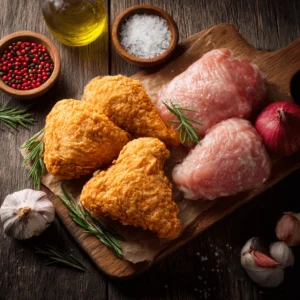
Perfectly seasoned flour ready to coat chicken for maximum crispiness
Chicken Selection: Best Cuts to Use
Choosing the right chicken is one of the most important steps in creating homemade fried chicken that is juicy, tender, and full of flavor. Not all cuts cook the same way, so knowing which pieces to use can make a huge difference in the final dish.
Dark Meat vs. White Meat
Thighs and Drumsticks (Dark Meat): These cuts are naturally juicier and more flavorful because of their higher fat content. They stay tender even during frying, making them perfect for achieving that signature crispy fried chicken texture without drying out.
Breast (White Meat): Chicken breasts are leaner and cook faster. While they can be slightly drier than dark meat, using a buttermilk marinade or brining beforehand can keep them moist while still achieving a crispy coating.
Bone-In vs. Boneless
Bone-In: Frying chicken with the bone in adds extra flavor and helps retain moisture. Traditional homemade fried chicken recipes often use bone-in pieces for that classic taste.
Boneless: These cook faster and are easier to serve, especially for sandwiches or smaller meals, but require careful monitoring to avoid overcooking.
Skin-On for Extra Crispiness
Leaving the skin on the chicken helps create a golden, crunchy outer layer. The skin acts as a natural barrier, keeping the meat juicy while crisping beautifully during frying. For homemade fried chicken, the skin is almost always recommended unless dietary preferences dictate otherwise.
Portion Sizes
Consistency matters. Choose pieces that are roughly the same size so they cook evenly. Large thighs or drumsticks may need slightly longer frying times, while smaller wings cook faster.
By selecting the right cuts—dark meat for juiciness, bone-in for flavor, and skin-on for crunch—you set the stage for a homemade fried chicken experience that rivals your favorite restaurants.
Marinade Ingredients for Juicy Flavor
A key secret to juicy, flavorful fried chicken is the marinade. Using the right combination of ingredients not only tenderizes the chicken but also infuses it with layers of taste that make your buttermilk fried chicken irresistible.
Buttermilk: The Magic Ingredient 🥛
Buttermilk is the cornerstone of a tender, juicy chicken marinade. Its mild acidity helps break down proteins in the chicken, ensuring every bite is soft and succulent. Soaking your chicken in buttermilk for at least 2–4 hours (or overnight for best results) guarantees maximum flavor penetration and tenderness.
Seasonings and Spices 🌶️
Enhance the buttermilk with a flavorful spice blend to create a chicken marinade that packs a punch. Common additions include:
Salt & Black Pepper: Basic seasoning to bring out the natural chicken flavor.
Paprika: Adds a mild sweetness and beautiful color.
Garlic Powder & Onion Powder: Boosts savory depth.
Cayenne Pepper or Chili Powder: For a gentle heat, if desired.
Optional: dried herbs like thyme or oregano for an aromatic twist.
Additional Flavor Boosters 🍋
Some cooks add a splash of hot sauce to the buttermilk marinade to give the chicken a tangy kick that enhances the fried coating.
A teaspoon of sugar or honey can help caramelize the crust during frying, adding a subtle golden-brown color and hint of sweetness.
Marinating Tips for Maximum Juiciness 💡
Make sure the chicken pieces are fully submerged in the marinade.
Cover and refrigerate to allow the flavors to penetrate deeply.
For even coating later, pat the chicken lightly with a paper towel before dredging in flour to remove excess buttermilk—this prevents soggy breading.
By combining buttermilk with a well-balanced chicken marinade, you create the perfect foundation for tender, juicy meat with rich flavor. This step is essential for anyone aiming to make the best homemade fried chicken.
Breading and Seasoning Essentials
The secret to truly unforgettable homemade fried chicken lies in the breaded coating. A golden, crispy coating packed with flavor is what separates ordinary fried chicken from the best fried chicken recipe. Here’s how to master it:
The Flour Base 🌾
Start with all-purpose flour, which forms the foundation of your crispy coating. Some cooks mix in a bit of cornstarch or rice flour to make the crust extra light and crunchy. The flour ensures that the fried chicken seasoning adheres evenly to every piece.
Seasoning the Flour 🌶️
Flavoring the flour is crucial. A simple dredge of unseasoned flour will yield bland fried chicken. Instead, combine flour with:
Salt & black pepper for basic seasoning
Paprika for color and mild smokiness
Garlic powder & onion powder for savory depth
Cayenne pepper or chili powder for a touch of heat
This creates a fried chicken seasoning that’s flavorful from the first bite to the last.
Double-Dredge for Extra Crunch
For an extra crispy coating, consider a two-step dredging process:
Dip the marinated chicken into flour mixture
Dip briefly back into the buttermilk (or egg wash)
Coat again in the seasoned flour
This technique produces a thicker, crunchier crust that holds up perfectly when frying.
Optional Additions for Texture & Flavor
Panko breadcrumbs or crushed crackers can be mixed into the flour for a unique crunch.
Herbs like dried thyme or oregano can add subtle aromatic notes that complement the spices.
Pro Tips for Even Coating 💡
Shake off excess flour before frying to prevent clumps from forming.
Ensure every piece is evenly coated for uniform browning.
Avoid overcrowding the pan—frying in batches ensures the coating stays crisp and golden.
By combining flour, spices, and the right techniques, you create the perfect crispy coating that makes every bite of your fried chicken flavorful and irresistible. This step is essential to achieving a homemade fried chicken that rivals your favorite restaurant.
Preparing the Chicken Step-by-Step
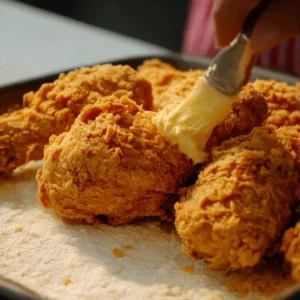
Ensuring an even coating for golden, crunchy fried chicken
Marinating the Chicken for Maximum Flavor
One of the most important steps to achieve juicy fried chicken is a proper chicken marinade. The marinade not only tenderizes the meat but also infuses it with rich, layered flavors that make your fried chicken stand out.
The Role of the Marinade 🥛
A good marinade softens the chicken fibers, ensuring every bite remains tender and moist. Using ingredients like buttermilk, yogurt, or a light brine provides acidity that breaks down proteins naturally. This step is key for creating a juicy fried chicken recipe that’s flavorful from the inside out.
Essential Ingredients for Flavor 🌶️
Beyond buttermilk, your chicken marinade should include:
Salt & pepper to season the meat evenly
Paprika and cayenne pepper for mild heat and color
Garlic and onion powder for savory depth
Optional: a splash of hot sauce or vinegar to enhance tanginess and flavor penetration
These ingredients ensure that the chicken is well-seasoned, even before it hits the flour coating.
Marinating Tips for Maximum Juiciness 💡
Time Matters: Marinate the chicken for at least 2–4 hours; overnight is ideal for the deepest flavor.
Full Coverage: Make sure each piece of chicken is completely submerged or coated in the marinade to allow even flavor absorption.
Refrigeration: Always marinate in the refrigerator to prevent bacterial growth.
Extra Tips for Flavor Layering ✨
For added complexity, consider adding fresh herbs like thyme, rosemary, or parsley to the marinade.
A small amount of sugar or honey can balance the spices and help the coating brown beautifully during frying.
By taking the time to properly marinate your chicken, you set the stage for a juicy fried chicken recipe with deep, irresistible flavor. This step ensures that each bite is tender, savory, and perfectly seasoned—exactly what makes fried chicken so crave-worthy.
Coating and Breading Techniques
The secret to achieving perfectly crispy fried chicken lies in your breading for chicken. How you coat the chicken before frying determines whether your chicken will be golden and crunchy or soggy and uneven. Here’s how to master the technique:
Dry vs. Wet Dredge 🌾
Dry Dredge: After marinating, pat the chicken pieces lightly with paper towels. Then dredge them directly in a seasoned flour mixture. This method gives a lighter, crispier coating.
Wet Dredge (Double Dredge): For a thicker, crunchier crust, dip the marinated chicken back into the buttermilk or an egg wash, then coat it again in flour. This double dredging technique ensures the coating sticks well and becomes extra crispy.
Seasoning the Coating 🌶️
Your flour mixture should be seasoned generously with salt, pepper, paprika, garlic powder, onion powder, and cayenne. This step adds another layer of flavor and complements the marinade inside the chicken.
Mixing in cornstarch or panko breadcrumbs can also enhance crunch, giving your fried chicken a light, airy, and crispy coating that lasts.
Even Coating Techniques 💡
Shake off excess flour before frying to prevent clumping and uneven browning.
Press the coating gently onto the chicken pieces to ensure it adheres evenly.
Place coated chicken on a wire rack for a few minutes before frying. This allows the coating to set and helps maintain crispiness during frying.
Optional Flavor Boosters ✨
Add herbs or spices directly to the flour mixture for extra aroma.
A pinch of sugar in the flour can help create a golden-brown color.
For extra crunch, consider a mix of flour and finely crushed cornflakes or crackers.
By carefully following these breading for chicken steps and seasoning thoughtfully, you ensure your crispy coating is perfectly golden, flavorful, and stays crunchy long after frying. Mastering this step is what elevates homemade fried chicken to restaurant-quality perfection.
Tips for Even Cooking
Cooking southern fried chicken perfectly isn’t just about the seasoning or coating—it’s also about even cooking. Uneven frying can result in burnt crusts and undercooked meat, which ruins a step-by-step fried chicken guide. Here’s how to make sure every piece comes out golden and juicy:
Maintain the Right Oil Temperature 🌡️
Use a deep-fry thermometer to monitor the oil. The ideal temperature for frying chicken is around 325°F–350°F (160°C–175°C).
Too hot, and the crispy coating will brown too quickly while leaving the inside undercooked.
Too low, and the coating absorbs too much oil, becoming greasy instead of crunchy.
Fry in Batches 🥘
Avoid overcrowding the pan. Frying too many pieces at once lowers the oil temperature and causes uneven cooking.
Fry 3–4 pieces at a time depending on your pan size to ensure each piece cooks evenly and maintains its southern fried chicken crispiness.
Timing by Chicken Cut ⏱️
Dark meat (thighs, drumsticks) takes longer to cook than white meat (breasts). Keep an eye on internal temperature: chicken is safe to eat at 165°F (74°C).
A step-by-step fried chicken guide should remind readers to adjust cooking times based on the size and cut of the chicken pieces.
Drain Properly 🧺
After frying, place chicken on a wire rack instead of paper towels. This allows excess oil to drain without making the crispy coating soggy.
Resting the chicken for a few minutes before serving also helps redistribute juices, keeping the meat moist inside.
Optional Tips for Extra Crispiness ✨
Keep the oil at a consistent medium-high heat throughout frying.
Flip the chicken only once or twice to avoid disturbing the breading.
If some pieces brown faster, remove them first and let the others finish cooking at a slightly lower temperature.
By following these techniques, your southern fried chicken recipe will be golden on the outside, juicy on the inside, and perfectly cooked every time. This ensures that anyone using your step-by-step fried chicken guide can replicate restaurant-quality results at home.
Cooking Methods for Crispy Fried Chicken
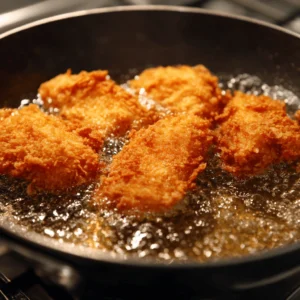
Cooking fried chicken in hot oil for a golden, crispy finish
Pan-Frying vs. Deep-Frying
When it comes to making homemade fried chicken, choosing the right frying method can significantly impact the texture, flavor, and overall results. Understanding the differences between pan-frying and deep-frying ensures that your chicken comes out perfectly golden and juicy every time.
Pan-Frying 🍳
Method: In pan-frying, chicken pieces are partially submerged in hot cooking oil inside a frying pan, usually covering about halfway up the sides of the chicken.
Benefits:
Requires less oil than deep-frying, making it slightly lighter.
Easier to manage smaller portions for family meals.
Gives a rich, slightly crispy texture with good flavor absorption from the pan’s bottom.
Tips:
Turn the chicken frequently to ensure even browning.
Monitor oil temperature closely; medium-high heat works best to avoid soggy coating or burnt crust.
Deep-Frying 🛢️
Method: In deep-frying, chicken is fully submerged in hot oil inside a deep fryer or heavy pot.
Benefits:
Produces a perfectly even, crispy coating all around.
Cooks faster than pan-frying, as hot oil surrounds the chicken entirely.
Ideal for larger batches or for achieving classic southern fried chicken texture.
Tips:
Use a thermometer to keep the oil between 325°F–350°F (160°C–175°C).
Fry in small batches to prevent temperature drops that can make the chicken greasy.
Let chicken rest on a wire rack after frying to maintain crispiness.
Choosing the Right Oil 🌿
Both methods benefit from oils with high smoke points, like peanut oil, canola oil, or vegetable oil, which allow the chicken to fry evenly without burning.
Avoid extra-virgin olive oil for frying—it has a low smoke point and can affect flavor.
Which Method is Best? 🤔
Pan-Frying: Great for smaller portions, lighter meals, or if you want slightly less crispy but flavorful chicken.
Deep-Frying: Best for classic, restaurant-style fried chicken with a fully golden, crispy coating and juicy interior.
By understanding the differences between pan-frying and deep-frying, and selecting the right oil and equipment, you can confidently achieve perfectly cooked, flavorful homemade fried chicken every time.
Temperature and Timing Tips
Cooking golden brown chicken that’s crispy on the outside and juicy on the inside requires careful attention to temperature and timing. Whether you’re following a quick fried chicken recipe or a more traditional method, mastering these elements ensures consistent, delicious results every time.
Monitor Oil Temperature 🌡️
The ideal frying temperature is between 325°F–350°F (160°C–175°C).
Too hot: The coating browns too quickly, leaving the chicken undercooked inside.
Too low: The chicken absorbs too much oil, resulting in greasy, soggy crust.
Use a deep-fry thermometer to maintain steady heat for perfectly golden brown chicken.
Timing by Cut and Size ⏱️
Dark meat (thighs, drumsticks) takes longer to cook than white meat (breasts, wings).
A quick fried chicken recipe usually uses smaller cuts or boneless pieces, which cook faster—typically 10–12 minutes per batch depending on size.
Bone-in pieces may need 12–15 minutes, so adjust accordingly and check the internal temperature (safe chicken reaches 165°F / 74°C).
Batch Frying for Consistency 🥘
Fry in small batches to prevent overcrowding the pan, which drops oil temperature and leads to uneven cooking.
Let oil return to the correct temperature between batches to maintain consistent crispy coating and golden color.
Resting After Frying 🧺
Place fried chicken on a wire rack instead of paper towels. This allows excess oil to drain and keeps the coating crisp.
Let chicken rest for 5 minutes before serving so juices redistribute, keeping meat moist and tender.
Quick Tips for Perfect Timing ✨
Keep a timer handy for each batch to avoid overcooking.
Rotate chicken pieces gently during frying to ensure even browning.
Adjust heat as needed; if the coating browns too fast, lower the temperature slightly.
By carefully controlling temperature and timing, your fried chicken will achieve a golden brown exterior with a juicy interior, whether you’re making a quick fried chicken recipe for weeknight dinners or an elaborate homemade feast.
Avoiding Common Frying Mistakes
Even the best crispy fried chicken recipe can go wrong if you’re not careful during frying. Understanding common pitfalls and following practical frying tips ensures your chicken comes out perfectly golden, crunchy, and juicy every time.
Overcrowding the Pan 🥘
Placing too many chicken pieces in the frying pan or deep fryer at once lowers the oil temperature.
This leads to uneven cooking, greasy coating, and soggy chicken.
Tip: Fry in small batches, giving each piece enough space for even browning and crispiness.
Incorrect Oil Temperature 🌡️
Too hot: The outside burns before the inside cooks through.
Too low: The chicken absorbs excess oil, resulting in a greasy, limp crust.
Tip: Use a thermometer to maintain 325°F–350°F (160°C–175°C) for consistent results in your crispy fried chicken recipe.
Skipping the Resting Stage 🧺
Removing fried chicken and serving immediately can cause juices to leak out, making the coating less crunchy.
Tip: Place fried chicken on a wire rack for 5–10 minutes. This drains excess oil and allows the juices to redistribute, keeping the meat moist and the coating crisp.
Uneven Coating 🌾
Flour or breadcrumb coatings that are too thick in some areas or too thin in others can burn or remain undercooked.
Tip: Press the breading gently onto the chicken and shake off excess flour before frying. A uniform coating ensures evenly golden, crunchy chicken.
Ignoring Marinade and Timing ⏱️
Frying chicken that hasn’t been properly marinated or brined can result in dry meat.
Overcooking small pieces or undercooking larger pieces can ruin the dish.
Tip: Follow a step-by-step fried chicken guide, adjust frying times based on size, and always check internal temperature (165°F / 74°C).
Using the Wrong Oil 🛢️
Low smoke point oils can burn, giving an unpleasant flavor.
Tip: Use neutral, high smoke point oils like peanut, canola, or vegetable oil for the best frying results.
By avoiding these common mistakes and following these frying tips, you can consistently create a crispy fried chicken recipe with golden-brown coating, juicy meat, and rich flavor that rivals restaurant-style fried chicken.
Serving and Pairing Ideas
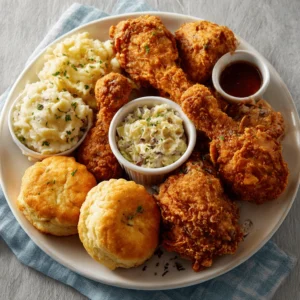
Enjoy fried chicken with traditional Southern side dishes for a complete meal
Classic Side Dishes for Fried Chicken
No southern fried chicken recipe is complete without the perfect accompaniments. Pairing your crispy fried chicken with classic sides enhances the meal, balances flavors, and delivers a true comfort-food experience. Here are some timeless options:
Mashed Potatoes 🥔
Creamy, buttery mashed potatoes are the ultimate side for fried chicken. Their soft texture contrasts perfectly with a crispy coating, creating a harmonious bite.
Tip: Add a little gravy or chicken drippings for extra richness and flavor that complements the savory fried chicken.
Coleslaw 🥗
This tangy, crunchy salad is a staple alongside fried chicken. Made with shredded cabbage, carrots, and a light mayonnaise or vinegar dressing, coleslaw adds freshness and balances the richness of the fried coating.
Optional: Include apple slices or a touch of mustard for added flavor and a Southern-style twist.
Biscuits 🥖
Fluffy, golden biscuits are a Southern classic. Their buttery, soft interior makes them ideal for sopping up juices and gravy from your fried chicken.
Tip: Serve warm with a bit of butter or honey for a true homemade fried chicken experience.
Other Popular Sides ✨
Mac and Cheese: Creamy cheese sauce with tender pasta complements the crunchiness of fried chicken.
Green Beans or Collard Greens: Adds color, nutrients, and a light, fresh contrast to the meal.
Corn on the Cob: Sweet, buttery corn is another Southern favorite that pairs beautifully with golden fried chicken.
Pairing your fried chicken with these classic sides transforms a simple meal into a comfort-food feast. These combinations highlight the richness and flavor of your chicken while offering variety in texture and taste—perfect for family dinners, special occasions, or a Southern-inspired feast at home.
Sauces and Dips That Enhance Flavor
A perfectly cooked crispy fried chicken deserves equally delicious accompaniments in the form of sauces and dips. In Southern cuisine, these sauces not only complement the fried chicken seasoning but also elevate the dish by adding layers of flavor and richness.
Classic Honey Mustard 🍯
A sweet and tangy honey mustard dip balances the savory, spiced coating of your fried chicken.
Made with honey, mustard, mayonnaise, and a touch of lemon juice, this sauce is perfect for dipping drumsticks, wings, or chicken tenders.
Buttermilk Ranch 🥛
Creamy and cooling, ranch is ideal for those who enjoy a mild, flavorful dip that complements the crispy coating without overpowering the chicken.
Combine mayonnaise, sour cream, buttermilk, garlic powder, and fresh herbs for an authentic, homemade ranch sauce.
Spicy Buffalo Sauce 🌶️
For a kick of heat, try a buffalo-style dip. This spicy, buttery sauce enhances the fried chicken seasoning and adds bold flavor.
Ideal for wings or tenders, it pairs wonderfully with a side of coleslaw to balance the spice.
Classic Southern Gravy 🍗
A rich, savory gravy made from pan drippings adds deep flavor and moisture to your fried chicken.
In Southern cuisine, chicken gravy often includes flour, butter, chicken broth, and seasonings. Pour over chicken and mashed potatoes for a comforting, hearty meal.
Optional Creative Dips ✨
Barbecue Sauce: Smoky and sweet, perfect for adding another layer of flavor to your fried chicken.
Garlic Aioli: Creamy and slightly garlicky, ideal for sandwiches or as a dipping sauce.
Hot Honey: Combines sweetness with a spicy twist for a modern Southern-inspired touch.
By pairing your crispy fried chicken with these sauces and dips, you can tailor the flavor experience to suit every palate. From sweet and tangy to spicy and rich, these accompaniments highlight the best of Southern cuisine and make every bite even more irresistible.
Presentation Tips for Family and Guests
Even the best fried chicken recipe can be elevated with thoughtful presentation. How you serve your chicken can make it feel like a special occasion and impress family or guests, turning a simple meal into a memorable dining experience.
Use a Platter or Wooden Board 🍽️
Arrange your crispy fried chicken on a large platter or rustic wooden board to showcase the golden, crunchy pieces.
Layer pieces slightly to create height and visual appeal, making the dish look abundant and inviting.
Garnish with Fresh Herbs and Citrus 🌿🍋
Sprinkle chopped parsley, thyme, or rosemary over the chicken for a pop of color and fresh aroma.
Lemon wedges on the side not only add visual interest but also allow guests to add a zesty brightness that complements the fried chicken seasoning.
Coordinate Side Dishes Creatively 🥗🥔
Arrange classic sides like mashed potatoes, coleslaw, and biscuits around the chicken or in separate dishes on the table.
Use colorful serving bowls or ramekins for sauces and dips to make the plate vibrant and organized.
Consider Individual Portions 🥘
For a family-style meal, pre-portion chicken pieces for each guest along with sides.
This makes it easier to serve and adds a sense of care and attention, enhancing the dining experience.
Add a Finishing Touch ✨
Lightly brush chicken with a thin layer of melted butter after frying to give it a subtle shine and extra flavor.
Sprinkle a pinch of sea salt or cracked black pepper just before serving to enhance the crispy coating and flavor.
By taking a few extra steps in presentation, you elevate your best fried chicken recipe from a simple meal to a feast that looks as good as it tastes. Thoughtful plating, garnishes, and coordinating sides create an inviting, Instagram-worthy spread that will delight both family and guests.
Tips, Tricks, and Variations
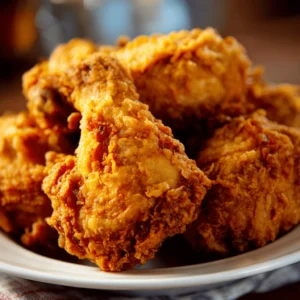
Homemade fried chicken with a golden, crunchy coating, ready to impress family and guests
How to Make Fried Chicken Healthier
While nothing beats the indulgent crunch of homemade fried chicken, there are simple ways to make it a bit healthier without sacrificing flavor or texture. By making smart choices with ingredients and cooking techniques, you can enjoy your favorite dish more often.
Choose Leaner Cuts of Chicken 🐔
Opt for skinless chicken breasts or thighs if you want to reduce fat content.
Dark meat with skin is juicier but higher in fat, so balancing lean cuts with flavorful seasoning ensures a satisfying meal without excess calories.
Use Healthier Cooking Oils 🛢️
Select oils with high smoke points and healthier fat profiles, like canola oil, avocado oil, or peanut oil.
Avoid partially hydrogenated oils or butter for frying, which increase saturated fat.
Cooking oil tips: Maintain the correct frying temperature (325°F–350°F / 160°C–175°C) to prevent excess oil absorption, keeping your chicken lighter and less greasy.
Opt for Oven-Frying or Air-Frying 🔥
Oven-Frying: Coat chicken with seasoned flour or breadcrumbs and bake at 400°F (200°C) on a wire rack to allow excess fat to drip off.
Air-Frying: Uses minimal oil while still creating a crispy coating similar to traditional frying. Both methods reduce calorie content while retaining flavor.
Season and Marinate Smartly 🌿
Instead of relying solely on salt, use herbs, spices, and citrus to add bold flavors without extra sodium.
A buttermilk or yogurt marinade tenderizes chicken naturally and enhances taste without adding unhealthy fats.
Control Portions and Pair Wisely 🥗
Serve smaller portions of fried chicken alongside plenty of vegetables, salads, or whole grains.
Pairing with nutrient-rich sides balances the meal and makes it more wholesome.
By following these tips—choosing lean cuts, using healthier oils, exploring alternative cooking methods, and smart seasoning—you can enjoy homemade fried chicken that’s crispy, flavorful, and lighter. These small adjustments make it easier to enjoy this classic comfort food more often while keeping it a healthier option for family meals.
Flavor Variations: Spicy, Southern, or Buttermilk
One of the joys of making fried chicken at home is the ability to customize it to your taste. From classic Southern fried chicken recipes to tangy buttermilk fried chicken, the right flavor variation can elevate your homemade meal and make it unforgettable.
Classic Southern Fried Chicken 🍗
This traditional style emphasizes a crispy coating seasoned with a blend of paprika, garlic, onion powder, salt, and pepper.
Often cooked bone-in and skin-on, Southern fried chicken is juicy on the inside with a golden, crunchy exterior.
Serve with classic sides like biscuits, coleslaw, and mashed potatoes for an authentic Southern dining experience.
Spicy Fried Chicken 🌶️
For those who love a kick, a spicy fried chicken variation adds cayenne, chili powder, or hot sauce to the marinade and flour coating.
You can adjust the spice level to suit your palate—from mild heat to bold, fiery flavors.
Spicy fried chicken pairs perfectly with cooling sides like coleslaw or ranch dip to balance the heat.
Buttermilk Fried Chicken 🥛
Soaking chicken in buttermilk for several hours before frying tenderizes the meat and infuses it with rich, tangy flavor.
The acidity of buttermilk helps create a juicy interior, while the seasoned flour coating ensures a crispy exterior.
Buttermilk fried chicken is often lighter in flavor than the spicy variety but retains deep, savory richness—ideal for family meals or a classic homemade feast.
Other Creative Variations ✨
Herb-Infused: Add thyme, rosemary, or oregano to the flour for aromatic flavor.
Garlic Parmesan: Toss freshly fried chicken in garlic butter and parmesan for a modern twist.
Smoky BBQ: Brush fried chicken lightly with smoky barbecue sauce after frying for an irresistible glaze.
Experimenting with these flavor variations allows you to cater to different tastes while keeping your fried chicken exciting and versatile. Whether you choose a Southern fried chicken recipe, a spicy version, or a buttermilk fried chicken, each variation delivers that irresistible combination of juicy meat and crispy coating that makes fried chicken a beloved comfort food.
Storing Leftovers and Reheating Without Losing Crispiness
A crispy fried chicken recipe doesn’t have to be a one-meal affair. Proper storage and reheating techniques ensure that your fried chicken stays flavorful and retains its signature crispy coating for later enjoyment.
Proper Storage 🥡
Allow the fried chicken to cool slightly before storing to prevent condensation from making the coating soggy.
Use an airtight container or wrap pieces individually in parchment paper before placing them in the refrigerator.
Properly stored, fried chicken lasts 3–4 days in the fridge. For longer storage, freeze it in airtight bags for up to 2–3 months.
Reheating in the Oven 🔥
To maintain crispiness, avoid microwaving if possible. Instead:
Preheat the oven to 375°F (190°C).
Place chicken on a wire rack set over a baking sheet to allow hot air circulation.
Bake for 10–15 minutes for smaller pieces, or 15–20 minutes for larger cuts, until heated through.
This method keeps the coating crunchy while warming the chicken evenly.
Reheating in an Air Fryer 🍳
Air fryers are perfect for restoring crispiness:
Set the temperature to 350°F (175°C) and air fry for 5–8 minutes, depending on the size of the pieces.
Flip halfway for even reheating.
This method replicates the original fried texture better than a microwave.
Avoiding Soggy Chicken 💡
Never cover reheated chicken with a lid or foil during the first few minutes, as trapped steam softens the coating.
Use a wire rack or perforated baking tray to let air circulate around the chicken.
Optionally, lightly spray with cooking oil before reheating to refresh the crispy coating.
Tips for Freezing and Reheating ❄️
Flash-freeze fried chicken on a baking sheet before storing in freezer bags to prevent pieces from sticking together.
Reheat directly from frozen in the oven or air fryer, adding a few extra minutes to ensure the interior is hot.
By following these storage and reheating methods, you can enjoy your crispy fried chicken recipe for days without compromising flavor or crunch. This ensures that every bite, even as leftovers, is just as satisfying as when it was first made.
Making the best fried chicken recipe at home is easy with proper chicken selection, marinade, breading, and frying techniques. Whether you prefer classic Southern, spicy, or buttermilk variations, these tips ensure a juicy interior and crispy exterior. Serve with traditional sides or sauces to create a complete, mouth-watering meal that family and guests will love.
American Heart Association – Healthier Cooking Oils
- URL: https://www.heart.org/en/healthy-living/healthy-eating/eat-smart/fats/healthy-cooking-oils
- healthy cooking oil tips
- Provides guidance on using oils that reduce saturated fat while frying.
Learn more about healthy cooking oils to make your homemade fried chicken lighter without sacrificing flavor.
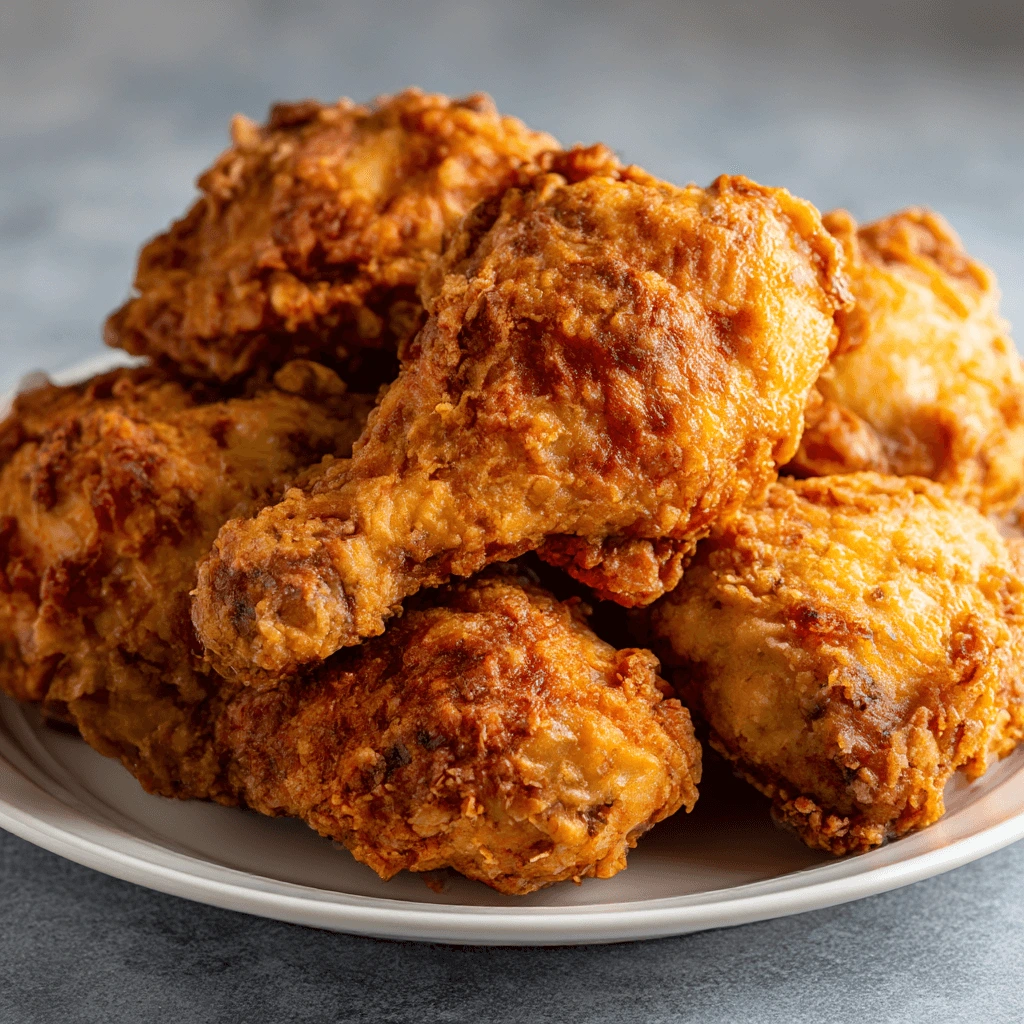
posted by Sub Zero Refrigerator Repair Chicago on October 27, 2025
In Chicago, residents have access to proficient fridge repair services located within the city. There’s no need to search any further if you’re seeking assistance from subzerorepair247.com.